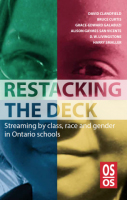The manner in which the school system in Ontario has been structured by those in power and the ways in which teachers are required to work within these prescribed boundaries are mainly at fault for the continued streaming of working class and minoritized children into non-academic programs, according to a new book co-written by a group of Ontario educators.
 Restacking the Deck: Streaming by Class, Race and Gender in Ontario Schools includes contributions by York University faculty George Martell and Harry Smaller and York alumna Alison Gaymes San Vicente, along with David Clandfield, Bruce Curtis, Grace-Edward Galabuzi and D.W. Livingstone. The book speaks about the need for a de-streamed schooling reform because many students are not being served well by the present streamed system.
Restacking the Deck: Streaming by Class, Race and Gender in Ontario Schools includes contributions by York University faculty George Martell and Harry Smaller and York alumna Alison Gaymes San Vicente, along with David Clandfield, Bruce Curtis, Grace-Edward Galabuzi and D.W. Livingstone. The book speaks about the need for a de-streamed schooling reform because many students are not being served well by the present streamed system.
The book is a follow up to 1992’s Stacking the Deck: The Streaming of Working Class Kids in Ontario Schools, which posed the question, “Will we waste another generation?” In this follow-up volume, the same question still remains: “Will we waste another generation over the next two decades?”
“While there is the appearance that the former academic, general and basic level high-school programs have been eliminated,” co-author Harry Smaller explained, “in fact, the new ‘pathways’ approach adopted by Ontario schools has resulted in even more insidious streaming of students. Present data clearly demonstrate that student success continues to be highly associated with student background.”
In addition to schooling structures, the pressure on teachers to cover a standardized curriculum, the lack of opportunities and resources for teachers to offer innovative curricula, courses and programs to students, and the multitude of regulations, policies and procedures, determine where and how teachers carry out their duties, and negatively influence the expectations they hold out for students. These factors, and many more, result mainly from conscious decisions made by administrators and politicians, not by teachers.
Ironically, teachers are being held more and more responsible for the results of a system over which they are given less and less control. And while the chapters do contain an Ontario focus, they speak to trends taking place in other jurisdictions, which makes this book a vital resource for those following the education debates, regardless of location.
As Smaller notes, ”Our hope is that this book will further discussion into the effects of our streamed schooling system, and into reforms which will effectively counter these long-standing and pervasive inequities in our schooling system.


